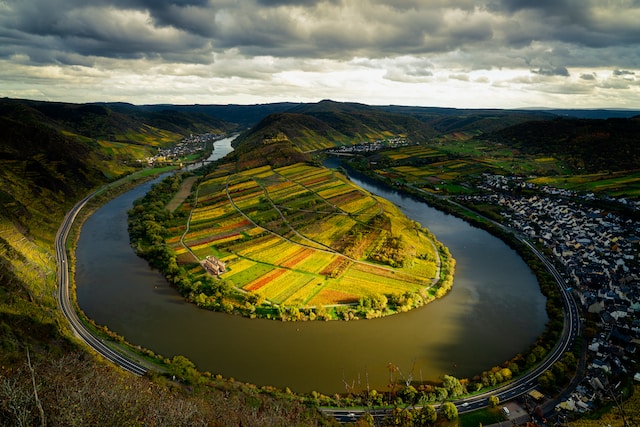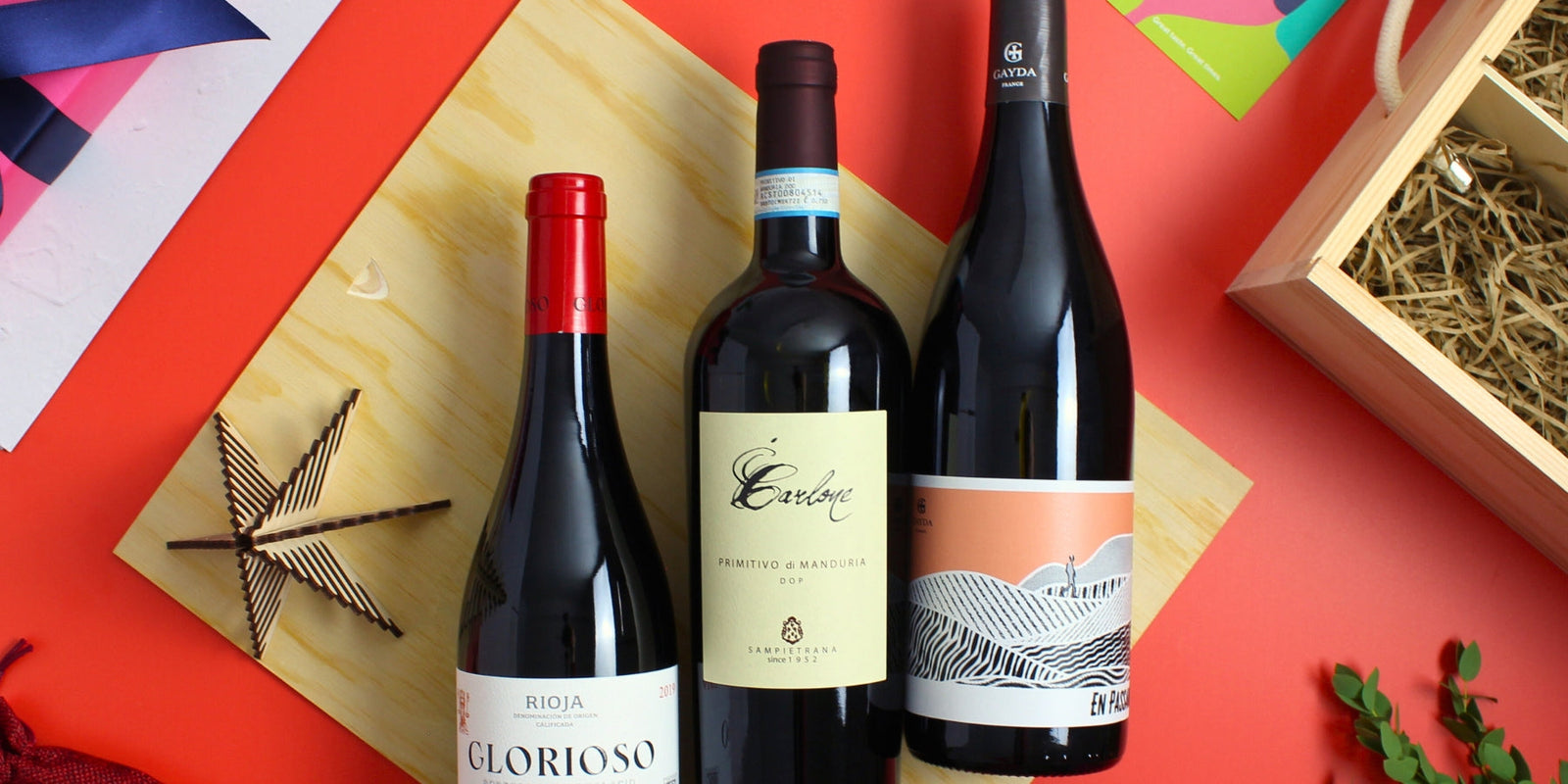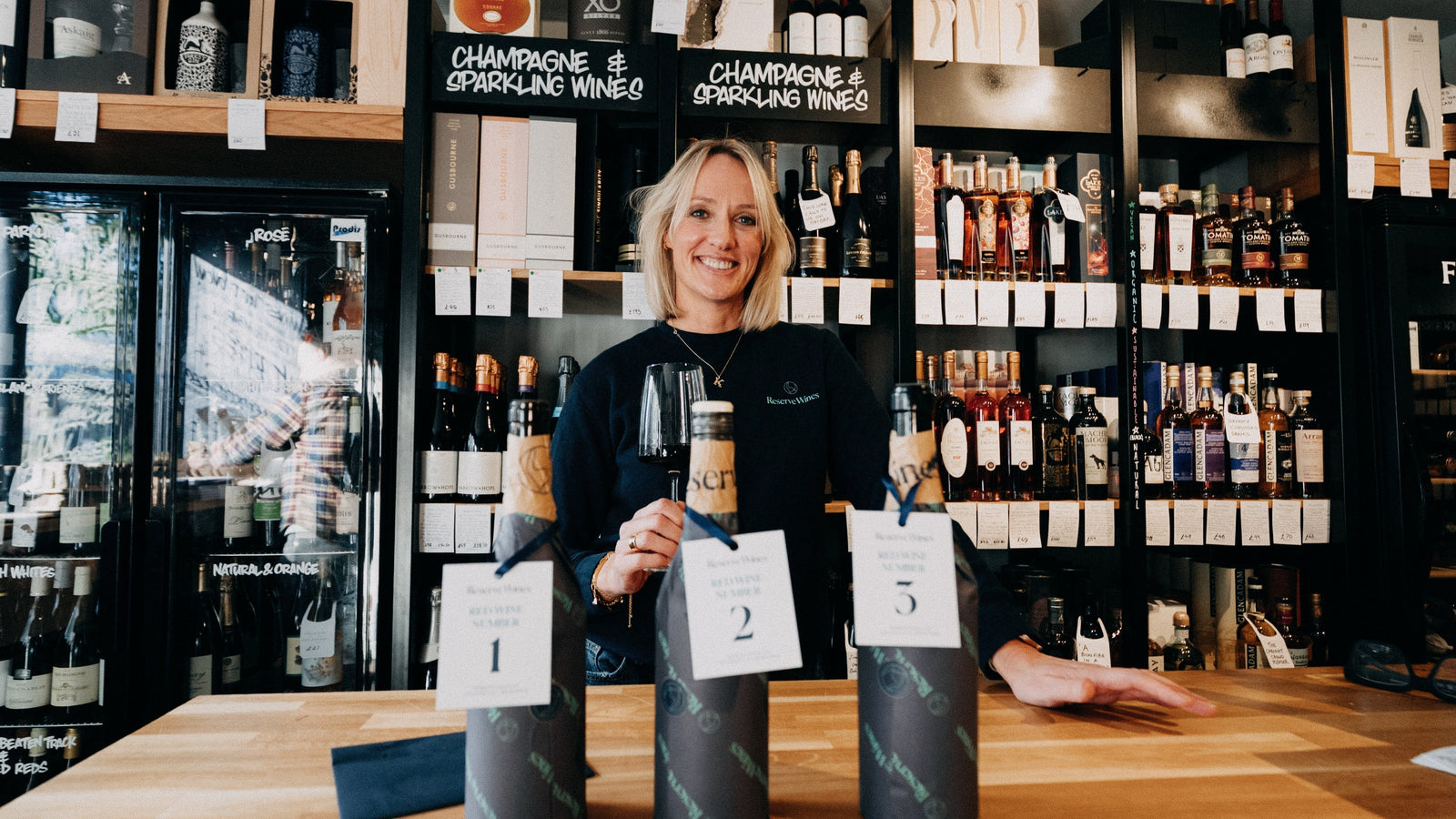During the summer months, we're looking for bright, zesty and summery wines and so it's only natural that we turn to Riesling wine. Wine made with Riesling grapes are alive with great energy. They have an electric tension and zing that makes them mouthwatering and refreshing. There are many examples ranging from dry to sweet and can have lower alcohol levels - ideal for a lunchtime glass or two, though many modern examples are dry and make for great alternatives to Sauvignon Blanc or Albarino.

There is one country that is synonymous with the Riesling grape and that is Germany. Germany is without doubt the home of Riesling. 45% of all the Riesling in the world is planted here and it accounts for a third of total wine production in the country. The country's relationship with Riesling has a long history stretching back to the 15th century when the grape was first documented in an invoice for Riesling vines purchased just east of the Rheingau.
German Riesling wine has a broad spectrum of aromas and flavours, ranging from citrus or crisp apple, to ripe peaches or tropical fruit, often layered with a mineral, herbal or spicy finesse.
It is cultivated in all 13 German wine-growing regions, traditionally in the steep or sloping valleys of the Rhine and Mosel Rivers. These regions are climatically influenced by the Gulf Stream and its moderate summer-winter temperature and Riesling thrives here on the south-facing hills that catch the most sunlight, however they are difficult to harvest mechanically.
Riesling is unparalleled in its ability to bring forth brilliant wines of all styles, from bone dry to lusciously sweet. It is also distinctive for its elegance, firm acidity, complexity, longevity – and extraordinary versatility with food, including the spicy or sweet-and-sour flavours of Asian or Latin American cuisine.
But while Riesling is the most important grape for this country, it has much more to offer. So let's take a look at some of the key grape varieties and regions that make up with this distinct and diverse wine country.
History
Wine making in Germany dates back as far as 200AD when the vines were brought into the country by the Roman Empire. German wine history dates back to Ancient Roman times. Vineyards spread across the country largely thanks to churches and monasteries, who set up a lot of the vineyards and wine regions across Germany that are still established today. The key grape varieties evolved during a centuries-long process of selection and the focus was in quality rather than quantity.

In 1775 at Schloss Johannisberg in Rheingau, a courier delivering the harvest permission was delayed for two weeks, with the result that most of the grapes in the vineyard had been affected by noble rot before the harvest began. Unexpectedly, these "rotten grapes" gave a very good sweet wine, which was termed Spätlese, meaning late harvest. From this time, late harvest wines from grapes affected by noble rot have been produced intentionally. This began a process of dividing and sorting the grapes based on harvested ripeness, and starting with Auslese in 1787, laid the ground for the Prädikat system.
In the 1800s, Napoleon took control of all the vineyards from the Church, including the best, and divided them. Since then the Napoleonic inheritance laws in Germany broke up the parcels of vineyards further, leading to the establishment of many cooperatives.
Despite this, the grape continued to be recognised as capable of producing fine wines and its reputation grew. In 1900, Egon Müller, the famed estate from the Mosel's Saar district, won a Grand Prix at the Paris Exposition International. Queen Victoria was also said to enjoy Riesling. It had arrived on the world stage.
The rise was not to last however as during the World Wars I and II many Riesling vines were destroyed. After the war the industry focused on quantity over quality planting more early ripening Silvaner and Rivaner vines, that were used to create mass-produced wines such as Liebfraumilch. These drove down sales of the single-estate wines, and quality Riesling became something of an insider secret for those who knew where to find it.
Today Riesling is once again the most widely planted grape in Germany and the quality to value ratio is excellent. With more dynamic small independent producers catering to modern palates with drier wines with great concentration and minerality. Riesling and German wine are growing in popularity again with the UK being the 6th biggest market, up 20% year on year and still growing.
Other Notable Grape Varieties
Spätburgunder (Pinot Noir)
If Germany’s finest white wines are produced from Riesling, its red wine counterpart is the Spätburgunder grape. Synonymous with top quality and legendary for its food compatibility, Spätburgunder yields mouth-filling, velvety smooth wines with slightly sweet, fruity, spicy, and floral aromas. With their softer tannins, they are more charming and accessible (less astringent) in their youth than the likes of Cabernet Sauvignon. The wines go well with roasted poultry, meat, and game; cheese; grilled or smoked salmon or tuna; and the flavours and spices of many Asian cuisines.
Weissburgunder (Pinot Blanc)
This grape creates elegant white wines with refreshing acidity, a fine fruitiness, and aromas reminiscent of pineapple, nuts, apricots or citrus. They can be excellent with light meats and seafood.
Silvaner
An ancient variety that yields full-bodied, juicy wines with a fine-fruity acidity. Neutral enough to enhance the delicate flavours of seafood and light meats or white asparagus. Traditionally grown in Franken and Rheinhessen.
Rivaner (Muller-Thurgau)
A drier, more food-compatible version of its synonym Muller-Thurgau. The
wines are flowery, with a light Muscat tone, and not too acidic – easy on the palate. They go well with herbed foods, salads, and vegetable dishes. Enjoy while young and fresh.
Gewürztraminer
Gewürztraminer is one of the oldest grape varieties still cultivated. Although plantings have increased slightly during the past few years, it accounts for less than one percent of Germany’s total vineyard area, primarily grown in Pfalz and the Rheinhessen.

Key wine-making regions
While there are 13 quality wine regions, we're going to focus on just 5 key regions that cover the majority of the wines we offer.
Mosel
Known for having the steepest Riesling Vineyards in the world. The valleys of the Mosel River and its tributaries, the Saar and the Ruwer, have been the setting for some of Germany’s most romantic wine country since Roman times. Vines and forests carpet the steep slate slopes framing the river as it loops its way toward the Rhine at Koblenz. It is a Riesling region par excellence. These are wines of wonderful finesse, rich in fragrance, fruity acidity and often have a mineral undertone.
Wines to try:

Axel Pauly, Generations Riesling Feinherb
Axel Pauly is one of the dynamic young stars of German wine. Fittingly, the label features the Mosel hills which, when turned on their side, reveals the ‘Tres Naris’ (or ‘three noses’) of Axel, his father and his grandfather. This is a great introduction to the wines of the Mosel, harvested from the family's steeply sloping vineyard in Lieser. Off-dry in style white with fresh hay aromas mingling with lemon citrus, pear and melon fruits. On the palate, the wine is tangy, with subtle fruits and a hint of minerality. The sweetness and high acidity are well balanced leading to a dry finish.
This would be delicious with a slightly spicy thai stir-fry.
Paul Schunk, Riesling Kabinett Lieblich
Weingut Paul Schunk is a 400 year-old family-run winery in the beautiful Mosel valley. Their sites, Fankeler Rosenberg or the Bruttiger Pfarrgarten, offer ideal conditions for Riesling with their steep slate slopes. Their fermentation process relies on natural yeasts from the grapes or the cellar environment.
Lieblich translates as lovely, charming or sweet and this harmonious and elegant example of dry Kabinett Mosel Riesling is very charming indeed. This has all spicy floral aromas with lime and peach fruit with a touch of apricot and a subtle honeysuckle note. Very intense with good acidity to balnce the sweetness and ending with a with a long finish. Try this with goats cheese, avocado and mango salad.

Nahe
Nestled between the Mosel and Rhine valleys, the Nahe is named after the river that traverses the forested Hunsrück Hills as it gently flows toward Bingen on the Rhine. Striking rock formations, mineral deposits and gemstones attest to the remarkable geological diversity that also accounts for the Nahe’s broad spectrum of wines. Sleek, piquant Riesling, fragrant Rivaner, and hearty Silvaner wines are longtime classics. White and red Pinots, e.g., Grauburgunder, Weissburgunder and Spätburgunder, and the red variety Dornfelder are on the rise.
Wine to try:

Hexamer No.1 Riesling 2018
A stellar example of Riesling developing with a bit of bottle age from Hexamer. We were all thrilled by Hexamer during last years celebration on Riesling, so we had high hopes for this and it does not disappoint. Made up of hand picked bunches of fully ripened grapes from Schlossböckelheimer In den Felsen (“In the Rocks”) a small vineyard that is markedly steep with south facing slopes composed of rocky porphyry and produces wines characterized by softer acidity and a subtle smokiness.
A nose of yellow peach, mirabelle plum, red apple, honey, and pepper leads to a concentrated, full-bodied palate with hints of honey, salt and flint smokiness on the long layered finish. This is juicy and fresh with a rich texture in the mouth that makes it very satisfying.
A delicious wine to pair with a creamy salmon dish or goats cheese.

Pfalz
One of the sunniest, driest wine regions. For 85 km (53 miles) the Deutsche Weinstrasse (German Wine Road) winds its way through the picturesque villages and lush vineyards between the borders of Rheinhessen and France. Vines thrive in the warm, sunny climate of the Pfalz, yielding voluptuous, full-bodied wines.
Riesling, the leading variety, and the white Pinots Weissburgunder and Grauburgunder are among the finest white wines, while Spätburgunder (Pinot Noir), Dornfelder and the rare St. Laurent are foremost for top-quality reds.
Wines to try:

Hanewald-Schwerdt, Riesling "Auf Der Pochel" Trocken
The Hanewald-Schwerdt estate is located at the end of the Pochelste Road. "Pochel" is a cairn people built when moving stones outside of the vineyards. Because of the fact that around Leistadt the land was never redeveloped these cairns became very typical for their landscape and gave the name to their excellent entry-level riesling. This is a dry Riesling with citrus & stone fruit aromas with nuances of melons and herbs. Silky, lively with nice acidity, it is super clean. Really great quality stuff. Look beyond the unassuming label you're in for a treat.
Try this one with pork belly with apple sauce.

Weingut Emile Bauer & Sohne, Sex Drugs Rock n Roll Riesling
Kate Says: "This is a great example of that warmer, riper style of Riesling that the Pfalz region is known for. Combined with the cheeky label this is a memorable wine that's a perfect summer refresher. I'd enjoy this with barbecued prawns."
Hanewald-Schwerdt, Spatburgunder Trocken
The family owned and operated estate Hanewald-Schwerdt was founded in 1955 in Leistadt. Today Thomas Hanewald & Stephan Schwerdt took over the family business which was established by their grandfather. The two cousins focus on Riesling and Pinot Noir. This is a delicious expression of Pinot Noir. Bright strawberry and cherry notes lead the way with some delicious savoury character and good minerality. With intense flavours and a light-medium body this is designed to be drunk easily and could be served with pigeon or duck, but also pairs well with mushroom based dishes.

Rheingau
The heart of the Rheingau borders the Rhine on its east-west course from Wiesbaden to Rüdesheim, where noble Riesling and Spätburgunder (Pinot Noir) vines carpet the slopes of the Taunus Hills. The region’s success is due to an optimal climate and an ongoing commitment to the high quality standards set centuries ago by the Benedictines at Johannisberg, the Cistercians at Kloster Eberbach and the local aristocracy. The fortuitous “Spätlese” (late harvest) at Johannisberg in 1775 set the stage for the rich, ripe botrytis wines for which Germany is renowned.
Wines to try:
SchlossVollrads,Rheingau Riesling GrosseGewachs “Schlossberg” 2019
Nowthat’s a more serious beast.It’s intense on the palate, crisp with apple fruit, subtle cooked apple,there’s a smoky spiciness about it, yetit’s very rigid in its delivery.There’s a textural acidity keeping everything superbly focused. One to decant, one to age, one to savour…maybe over a few days.

Rheinhessen
The “land of a thousand hills” lies within the large elbow formed by the Rhine as it flows from Worms to its bend at Mainz, then westward to Bingen. A region of this size, Germany’s largest, offers a great diversity of wines. Innovative varietals, such as RS (Rheinhessen Silvaner) or Selection Rheinhessen, and the increasing importance of white and red Pinots, highlight the region’s quality potential. The classic whites Rivaner, Silvaner and Riesling predominate, but aromatic varieties are grown too, as are the red grapes Portugieser and Dornfelder.
Wines to try
Deep Roots, Rheinhessen Riesling Trocken
A superb dry riesling from Germany that delivers aromas of fresh green apple and pear. A racy acidity that makes your mouth water and keeps you wanting more. This wine makes a great aperitif or freshener between courses but can be equally enjoyed on its own on a hot summers day.
Kate Says
"If you've ever been put-off by Riesling that was a little too sweet, this is the wine to win you back. This is dry and zesty and super refreshing. It's a great alternative to other dry whites like Albariño."
To get you started on your Riesling adventure we've put together a trio of our favourites or explore our full German wine range here.
German Wine Classifications
German wine classifications can be a bit confusing to begin with, but they are worth getting to know as they follow a logical progression, focusing on where the wine is from or the ripeness of the grapes. So if you want to know more join with us as we take a dive into Qualitatsweine, Pradikatsweine and VDP.

The most basic classfication covers a small proportion of simple Landweine (table wine) as well as wines without a protected indication of origin that are produced anywhere in Germany. This is simple, cheap, bulk wine.
QUALITÄTSWEINE (QbA)
The next step-up is the QbA that denotes a minimum level of ripeness, but primarily states that the grapes must be produced with from only 1 of the 13 designated regions. They use these terms to show levels of sweetness:
Trocken/Selection: A dry wine. The term “Selection” is specifically for the wines of Rheingau that have been hand-harvested.
Halbtrocken/Classic: A “half-dry” or slightly sweet wine.
Feinherb: An unofficial term to describe an off-dry wine similar to Halbtrocken
Liebliche: A sweet wine
süß or Süss: A very sweet wine
PRÄDIKATSWEINE
Germany’s premium quality wines that are made from fully ripe and/or botrytis-affected grapes which meant they were traditionally medium dry to sweet. It is most commonly used in the Mosel and was formally introduced in 1971. The following Prädikats (special attributes) denote six levels of ripeness and quality, and are measured by a scale of sweetness called Oechsle.
Kabinett - Fine, light wines made from ripe grapes. In general, they are low in alcohol.
Spatlese - Literally, late harvest. Elegant, well-rounded wines with the depth of flavor imparted by very ripe grapes.
Auslese - Noble wines, intense in bouquet and taste. Made from very ripe grapes selected in bunches.
Beerenauslese - Rare and exquisite wines with the unmistakable honey-like aroma of botrytis (“noble rot”). Made from overripe berries individually selected by hand.
Trockenbeerenauslese - The crowning achievement of German viticulture. A wine with a unique concentration of luscious, fruity sweetness made from individual berries shrivelled almost to raisins.
Eiswine - Unique wines made from grapes of BA quality, harvested and pressed while frozen. Thanks to their remarkable concentration of fruity acidity and sweetness, they have, perhaps, the greatest ageing potential of any wines in the world.

Then there is the VDP (Verband Deutscher Prädikatsweingüter) which is an independent association of around 200 wine estates that classify vineyards and have used the VDP.Adler, an established trademark for outstanding wines - for over 100 years. It was originally used only for dry, quality Rieslings but now includes a range of dry and sweeter styles. You see this most often on wines made outside of the Mosel, particularly in the regions around the Rheingau.
VDP.Gutswein - “House wine.” labeled with a proprietary, village or regional name and labeled “VDP.”
VDP.Ortswein - “Local village wine.” High quality vineyards within a village area labeled with a vineyard site name.
VDP.Erste Lage - “First site.” Vineyards designated first class with stricter growing standards. All wines are certified by tasting panel.
VDP.Grosses Gewächs / VDP.Grosse Lage - “Great site”/ ”Great growth.” A designation of the best vineyards with increased growing standards. All wines are certified by tasting panel. Wines labeled Grosses Gewächs (GG) must be dry.
In all, there are German winessuitable for every occasion – from an informal get together or picnic to the most elegant dinner or reception.









Leave a comment (all fields required)